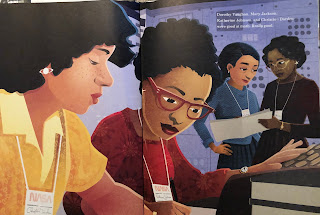
Title: Hidden Figures: The True Story of Four Back Women and the Space Race
Author: Margot Lee Shetterly Illustrator: Laura Freeman
Publisher: Harper Collins
Copyright: January 16, 2018
ISBN: 978-0062742469
Age Range: 4-8
Reading Level: Lexile-980
Cost: $16.19
Pages: 40
SUMMARY: Margot Lee Shetterly, who also authored the adult Hidden Figures as well as the Young Readers' Edition brings "the true story of four black women and the space race" to the an even younger audience. This picture books follows the lives of four African-American calculators who worked for NASA, and overcame racial and gender inequality in the workplace. For those who loved the movie, based on Shetterly's book, will appreciate this story being illustrated for young minds. These women were truly remarkable in their determination and left a lasting impression on the mathematics and aeronautics world as NASA's first African-American supervisor, first female African-American aerospace engineer, a part of the Flight Research Division, and an expert on sonic booms.
CRITIQUE: While this title does condense the original content of Shetterly's other versions, it brings important topics to a younger audience. The author provides a "Glossary" at the end of the book defining some of the more challenging vocabulary like "aeronautics, turbulence, and NASA. Katherine Johnson seems to get the most attention in other titles covering the space race and female African-American computers, but this picture book highlights all four women and their accomplishments. This is a great addition to STEM literature.
FEATURES INCLUDED: The book includes a "Timeline, Meet the Computers, Glossary, and Author's Note."
EXAMPLES:
Here you meet Dorothy Vaughan, Mary Jackson, Katherine Johnson, and Christine Darden. Laura Freeman's two page illustrations bring the mathematicians to life.
Freeman's illustrations show the segregation that was occurring in the south as well as the discrimination against women.
At the end of the book the author provides a timeline of the four mathematicians' careers and key flight events. There is also a brief biography about each of the four women at the end of the book.
Here you meet Dorothy Vaughan, Mary Jackson, Katherine Johnson, and Christine Darden. Laura Freeman's two page illustrations bring the mathematicians to life.
Freeman's illustrations show the segregation that was occurring in the south as well as the discrimination against women.
At the end of the book the author provides a timeline of the four mathematicians' careers and key flight events. There is also a brief biography about each of the four women at the end of the book.
COMPARISONS/RECOMMENDED READING:
Hidden Figures: Young Readers' Edition is in fact written by the same author, but is considered the Young Readers' Edition. The picture book edition was written for ages 4-8, whereas this edition was written for ages 8-12. While the content may be similar, this title explores the four African-American female computers more in-depth. You will not find the same level of illustrations in this title as the picture book version.
Counting on Katherine focuses on one of the mathematicians, Katherine Johnson, who was the main star of the hit movie Hidden Figures. The title could be used as a companion piece, read-aloud, or just to dig deeper into one of the women from Hidden Figures. The illustrations are lovely just like Shetterly's title.
After reading Hidden Figures, Little Leaders: Bold Women in Black History would make an excellent "next read." "Meet 40 trailblazing women who broke barriers of race and gender." All of these titles would be excellent choices to read for Black History Month, or utilized when teaching about civil rights and segregation. Katherine Johnson is also included in this title.
SUGGESTED USES: Shetterly's title would make an excellent addition to Black History Month displays, women in science/history displays, STEM reading clubs, etc. This title could also be used when discussing the civil rights movement, segregation, and equality. The following lesson plan uses Hidden Figures as part of a history lesson plan Women in history lesson plan. NASA also provides lesson plans through its' Modern Figures Toolkit.
Science & Engineering Processing Standards (SEPS)-Indiana State Academic Standards
SEPS.5-Using Mathematics and Computational Thinking
In both science and engineering, mathematics and computation are fundamental tools for representing physical variables and their relationships. They are used for a range of tasks such as constructing simulations; solving equations exactly or approximately; and recognizing, expressing, and applying quantitative relationships.






While I have read and love this book for all the reasons you go into, I must admit that I also have a little problem with it. Since there are so many other iterations of the "Hidden Figures" story, ranging from a movie, Movie soundtrack, novelization, juvenile novelization, and now this, it's a bit troubling to find the one you're looking for since they all share that same title. In any catalog that lacks the cover image, it would be all too easy for a patron to request the wrong book. So, while I love this book to pieces, I really wish they tried to come up with a different title to set it apart.
ReplyDeleteThey have differing sub-titles, but each use the same main "Hidden Figures." I can definitely see where this could be problematic when searching a catalog. However, if they used completely different titles people may not realize that this is a similar story.
ReplyDeleteEvie,
ReplyDeleteI appreciate the effort you put into this blog post, especially your suggested uses for the book and the tie-in with academic standards. It's always a welcome creative challenge to think through the many possibilities for using a book--the STEM book club idea would be a great way for a library to follow the general shift in focus toward STEM in schools.
I know we do a STEM program for home school students at my library. I could see a STEM book club that take place in the Makerspace in my library. They could read a title on their own, discuss the title while working on a relating STEM project.
Delete